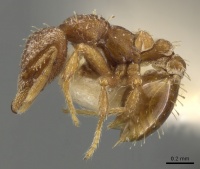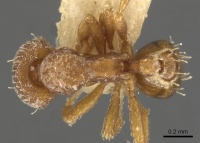Strumigenys themis
| Strumigenys themis | |
|---|---|

| |
| Scientific classification | |
| Kingdom: | Animalia |
| Phylum: | Arthropoda |
| Class: | Insecta |
| Order: | Hymenoptera |
| Family: | Formicidae |
| Subfamily: | Myrmicinae |
| Tribe: | Attini |
| Genus: | Strumigenys |
| Species: | S. themis |
| Binomial name | |
| Strumigenys themis (Bolton, 2000) | |
The two collections of this species are from rainforest, with one noted as being found in a rotten log.
Identification
Bolton (2000) - A member of the Strumigenys capitata-group. Characters differentiating themis and Strumigenys tethys are discussed under the latter name. Strumigenys charybdis is slightly smaller than themis, with relatively shorter mandibles (compare measurements) and much larger and more extensive spongiform appendages on the waist segments, as noted under charybdis.
Keys including this Species
Distribution
Latitudinal Distribution Pattern
Latitudinal Range: -4.694713° to -7.734722222°.
| North Temperate |
North Subtropical |
Tropical | South Subtropical |
South Temperate |
- Source: AntMaps
Distribution based on Regional Taxon Lists
Indo-Australian Region: Indonesia, New Guinea (type locality).
Distribution based on AntMaps
Distribution based on AntWeb specimens
Check data from AntWeb
Countries Occupied
| Number of countries occupied by this species based on AntWiki Regional Taxon Lists. In general, fewer countries occupied indicates a narrower range, while more countries indicates a more widespread species. |

|
Estimated Abundance
| Relative abundance based on number of AntMaps records per species (this species within the purple bar). Fewer records (to the left) indicates a less abundant/encountered species while more records (to the right) indicates more abundant/encountered species. |

|
Biology
Castes
Nomenclature
The following information is derived from Barry Bolton's Online Catalogue of the Ants of the World.
- themis. Pyramica themis Bolton, 2000: 407 (w.) NEW GUINEA. Combination in Strumigenys: Baroni Urbani & De Andrade, 2007: 129
Unless otherwise noted the text for the remainder of this section is reported from the publication that includes the original description.
Description
Worker
Holotype. TL 2.3, HL 0.56, HW 0.48, CI 86, ML 0.14, MI 25, SL 0.27, SI 56, PW 0.34, AL 0.66. Apicoscrobal and pronotal humeral hairs stout, thickened or weakly remiform apically. Eye with 4 ommatidia in the longest row. Dorsum of head with a transverse row of 4 standing hairs close to the occipital margin and with a pair of similar hairs just in front of the highest point of the vertex. Head and alitrunk reticulate-punctate almost everywhere, only the mesopleuron smooth and the anterior portion of the metapleuron with reduced punctation. Mesonotum with two pairs of short, remiform to weakly clavate standing hairs. Dorsal outline of propodeum in profile markedly convex between metanotal groove and teeth. With petiole in profile the dorsum with two pairs of standing hairs and the height of the anterior face of the node slightly less than the length of the dorsum (discounting the posterior collar). Spongiform appendages of waist segments small. Lateral lobe of petiole a mere angular flange that is no broader than the posterior collar. Ventral spongiform lobe of postpetiole in profile much smaller than the exposed cuticular area of the disc. Petiole node in dorsal view reticulate-punctate, slightly narrower than the postpetiole disc and not bordered laterally by extensive projecting lobes of spongiform tissue. Disc of postpetiole smooth or with faint traces of vestigial sculpture. Anterior and posterior collars present on postpetiole dorsum and with spongiform lobes extending from the posterolateral angles, but the remainder of the sides without projecting spongiform tissue.
Paratypes. TL 2.2-2.3, HL 0.53-0.56, HW 0.45-0.49, CI 85-89, ML 0.13-0.16, MI 25-29, SL 0.26-0.28, SI 55-60, PW 0.33-0.34, AL 0.60-0.68 (9 measured).
Type Material
Holotype worker, Papua New Guinea: Bubia, 13 km. NW Lae, 18-19.v.1955, no. 1063, lowland rainforest (E. O. Wilson) (Museum of Comparative Zoology).
Paratypes. 9 workers with same data as holotype (MCZ, The Natural History Museum).
References
- Baroni Urbani, C. & De Andrade, M.L. 2007. The ant tribe Dacetini: limits and constituent genera, with descriptions of new species. Annali del Museo Civico di Storia Naturale “G. Doria” 99:1-191.
- Bolton, B. 2000. The ant tribe Dacetini. Memoirs of the American Entomological Institute. 65:1-1028. (page 408, worker described)
References based on Global Ant Biodiversity Informatics
- Bolton, B. 2000. The Ant Tribe Dacetini. Memoirs of the American Entomological Institute 65
- CSIRO Collection
- Janda M., G. D. Alpert, M. L. Borowiec, E. P. Economo, P. Klimes, E. Sarnat, and S. O. Shattuck. 2011. Cheklist of ants described and recorded from New Guinea and associated islands. Available on http://www.newguineants.org/. Accessed on 24th Feb. 2011.
- Snelling R. R. 1998. Insect Part 1: The social Hymenoptera. In Mack A. L. (Ed.) A Biological Assessment of the Lakekamu Basin, Papua New Guinea, RAP 9. 189 ppages

